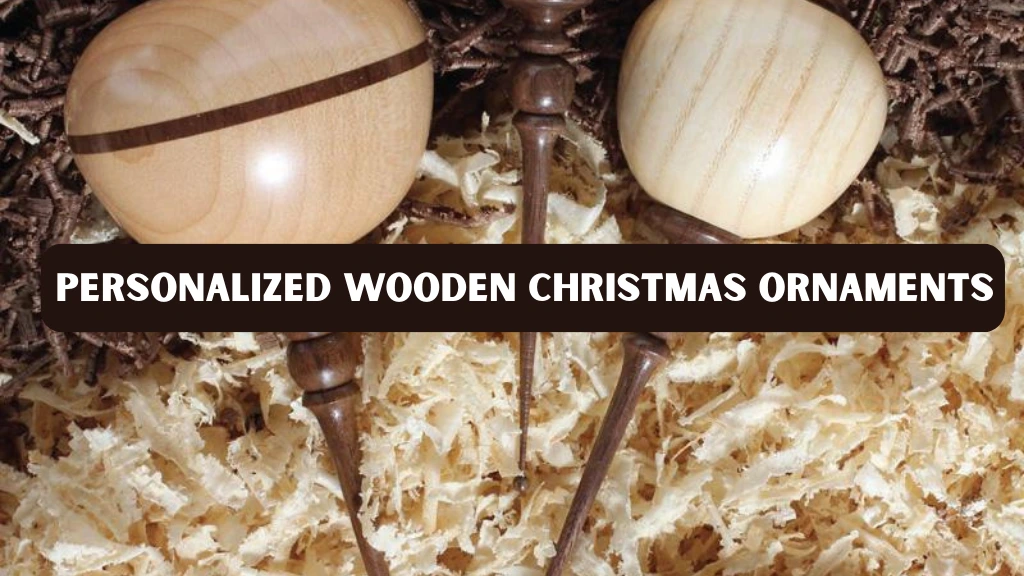Few holiday traditions feel as personal as decorating the Christmas tree. Among glass baubles, twinkling lights, and heirloom pieces, personalized wooden Christmas ornaments stand out for their rustic charm and heartfelt meaning. For woodworkers and lathe enthusiasts, crafting ornaments is not just about decoration; it is about creating keepsakes that blend artistry, tradition, and family stories. Whether you are turning your first ornament on the lathe or shopping for a handmade treasure, this guide will walk you through everything from crafting methods to styling, buying options, and long-term care.
Why Choose Personalized Wooden Christmas Ornaments
Wooden ornaments carry a timeless charm that makes them stand out from mass-produced holiday décor. Each piece showcases the natural grain of the wood, giving it warmth, character, and a truly one of a kind look. Unlike synthetic decorations, wood comes from renewable resources, making it a more sustainable option. When finished with eco-friendly oils or natural waxes, these ornaments not only look beautiful but also reflect responsible craftsmanship and environmentally conscious choices.
Beyond their practical appeal, personalized wooden Christmas ornaments hold deep sentimental value. Families often engrave, carve, or paint names, dates, and special messages, turning simple decorations into cherished heirlooms. With proper finishing and careful storage, they can last for decades, carrying memories of past holidays and becoming treasures passed down from one generation to the next. This enduring quality makes them more than just decorations; they are storytellers of family traditions and shared experiences.
Popular Ornament Styles and Lathe-Friendly Options
When selecting ornament styles, it is important to consider both aesthetics and skill level. Beginners often gravitate toward the classic ball ornament because it is relatively easy to shape on the lathe and provides valuable practice for achieving smooth curves. This style also highlights the natural beauty of the wood grain, making even a simple design visually appealing.
As skills improve, many turners move on to more intricate shapes. Finial ornaments, for example, require careful spindle turning to create delicate, elongated forms that bring elegance to the Christmas tree. Icicle drops are another favorite choice, but their slender profiles demand steady tool control and precision. For woodworkers who enjoy a challenge, hollow globes offer a rewarding project. These ornaments are lightweight and striking but require specialized hollowing tools and patience to achieve thin, even walls.
Simple shapes such as trees or bells strike a good balance between accessibility and decorative appeal, making them excellent for gift-giving or bulk projects. More advanced makers may even experiment with nested ornament sets, which consist of multiple pieces that fit inside one another. These not only demonstrate technical mastery but also spark conversations, often becoming the highlight of any holiday display.
How to Personalize Wooden Ornaments
The beauty of wooden ornaments lies in the endless opportunities for personalization. Engraving remains one of the most popular methods, allowing names, dates, or meaningful phrases to be etched directly into the surface with precision tools. Pyrography, or woodburning, offers a rustic aesthetic by creating intricate holiday scenes, initials, or decorative borders. Painting and staining provide another creative outlet, with metallic paints or vibrant colors enhancing the ornament’s appeal while letting the natural wood grain remain visible.
For those seeking more texture and depth, carving transforms ornaments into detailed works of art, with patterns such as snowflakes, stars, or family initials. Mixed media approaches are also gaining popularity, incorporating ribbons, beads, or fabric for added charm. When making personalized wooden Christmas ornaments, contrast is key: darker engravings work best on lighter woods like maple, while lighter designs stand out beautifully against walnut. By blending these methods, each ornament becomes a unique keepsake that reflects both skill and sentiment.
Detailed Lathe Ornament Project Ball with Finial
Creating a ball ornament with a finial begins with assembling the right tools and materials. A lathe, whether mini or full-size, is the heart of the process. Spindle gouges, a parting tool, and sandpaper from 150 to 600 grit are essential for shaping and smoothing. Hardwoods like maple, cherry, and walnut are excellent choices, finished with Danish oil, shellac, or lacquer for durability and shine.
The process starts by preparing the blank, cutting it to the proper size, and mounting it securely on the lathe. Careful setup ensures both safety and precision while turning. The blank is first rough-shaped into a sphere that becomes the body of the ornament. Once the ball is complete, attention shifts to the finial, where spindle techniques create slender tapers and graceful details.
Sanding comes next, moving through progressively finer grits to eliminate tool marks and highlight the natural grain. A well-executed sanding job gives the wood its final smoothness and polish. Finishing products, whether traditional oils or modern lacquers, enhance the color and add protection. Experienced turners often recommend natural finishes like beeswax for ornaments intended for family keepsakes.
The final stage involves assembly and personalization, making the piece truly unique. The finial is attached to the sphere using a mortise joint or strong adhesive. At this stage, names, dates, or festive designs can be engraved, burned, or painted onto the ornament. A small drilled hole at the top holds a screw eye or hanger, allowing the finished piece to take its place on the tree as a lasting heirloom.
Additional Lathe Ornament Ideas and Variations
Beyond the traditional ball with a finial, there are many creative directions to explore in ornament making. Hollow ornaments are a favorite among experienced turners, as thinning the walls reduces weight while creating a delicate, airy look that shines on large Christmas trees. Mini spindle clusters can also be turned in sets, then arranged along garlands, wreaths, or even table centerpieces, bringing handcrafted charm into multiple areas of holiday décor.
More advanced options include nested ornaments, where smaller pieces fit perfectly inside larger ones to showcase technical mastery and surprise recipients with a unique design. Some woodworkers also prefer to add sentimental value by reusing meaningful wood, such as salvaging material from last year’s Christmas tree. Once dried and prepared, this wood can be transformed into new ornaments, allowing families to carry the spirit of past holidays into future celebrations while preserving tradition in a beautiful, tangible way.
Where to Buy Wooden Ornaments
Not every family has access to a lathe, but that does not mean they have to miss out on custom wooden ornaments. Online retailers like PersonalizationMall and PersonalCreations offer a wide range of designs that can be personalized with names, messages, or dates. Artisan marketplaces such as Etsy connect buyers with independent woodworkers who create handmade ornaments with unique finishes and styles. Local craft fairs are another excellent source for one-of-a-kind pieces while also supporting community artisans.
Buying ornaments provides convenience, variety, and professional finishing, making them ideal for busy families. On the other hand, creating your own ornaments offers unmatched personalization, creative freedom, and the joy of learning a new skill. Many households choose to blend both approaches, purchasing some keepsakes while also making others at home. For readers interested in the historical roots of holiday ornaments, Britannica’s entry on Christmas trees offers a trustworthy background resource.
Styling and Decorating with Wooden Ornaments
The versatility of wooden ornaments allows them to fit beautifully into a wide range of decorating styles. In rustic farmhouse themes, they pair well with burlap ribbons, dried fruit, and pinecones to create a cozy and natural look. For modern minimalist homes, combining wooden ornaments with black, white, or metallic details brings an elegant contrast. Their ability to blend with materials like glass, metal, or felt makes them equally suitable for both traditional and contemporary designs.
Beyond the Christmas tree, wooden ornaments can be displayed in creative and unexpected ways. Many homeowners drape them along garlands on stair railings or use them as accents in festive table centerpieces. They also add a personal touch when incorporated into handmade wreaths or holiday wall décor. Personalized wooden Christmas ornaments adapt seamlessly to these varied uses, proving their value as versatile decorative pieces.
Care and Storage Tips
Proper care is crucial for preserving the beauty and longevity of wooden ornaments. Experts in woodworking recommend storing them in a cool, dry space to minimize the risk of warping or cracking. Exposure to direct sunlight should be avoided, as it can fade finishes or paints over time. Wrapping each ornament individually in tissue or cloth prevents scratches during storage, ensuring they remain in pristine condition for future holiday seasons.
To maintain both aesthetic and structural integrity, periodic upkeep is essential. Applying a light coat of finish every few years restores luster and adds a protective barrier against moisture. Professional woodturners also suggest conducting a quick annual inspection to check for cracks, loose joints, or fading, allowing for timely repairs. These small but consistent steps extend the lifespan of ornaments, helping families preserve their sentimental and decorative value for generations.
Real-World Examples and Stories
Stories from woodworkers highlight the emotional connection these ornaments foster. Many turn ornaments each year as part of a family tradition, with each piece added to a growing collection that tells the story of the maker’s journey. Families often personalize ornaments to mark important milestones such as the purchase of a first home, a child’s first Christmas, or a wedding anniversary.
Some artisans even craft personalized wooden Christmas ornaments from reclaimed wood taken from old barns, furniture, or trees with sentimental value, giving the material a second life and preserving family heritage. These real-world examples demonstrate that personalized wooden ornaments are not just decorative but deeply meaningful symbols of continuity and creativity.
Conclusion
Personalized wooden Christmas ornaments are far more than decorations; they are family keepsakes, creative projects, and thoughtful gifts. Whether you craft them on your lathe or purchase them from skilled artisans, they bring warmth, tradition, and personal meaning to the holidays.
For those inspired to try turning their own ornaments, additional guides on tool sharpening, wood types, and finishing techniques provide valuable knowledge to take your woodworking further. This holiday season is the perfect time to create or collect ornaments that will not only decorate your tree but also carry your family’s stories for years to come.
FAQs
Are wooden ornaments durable compared to glass?
Yes, they are far more durable if properly finished and stored, making them safer for families with children or pets.
How long does turning and personalization take?
A simple ornament can be completed in one to two hours, while intricate designs may take several evenings of careful work.
Can I make ornaments in bulk?
Yes, especially with straightforward designs such as balls or bells. Many woodworkers prepare batches of blanks in advance, making the turning process faster and more efficient.
Are finishes safe for kids?
Food-safe finishes such as mineral oil or beeswax are recommended when ornaments will be handled frequently by children.
What is the cost range?
The cost of making ornaments at home is usually minimal, with wood blanks costing only a few dollars each. Purchased handmade ornaments vary in price, generally between 15 and 50 dollars depending on size, detail, and personalization.




